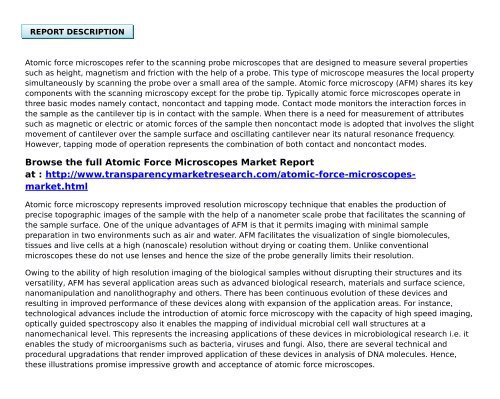Atomic Force Microscopes Market - Global Industry Analysis, Size, Share, Growth, Trends And Forecast 2014 – 2020
Atomic force microscopes refer to the scanning probe microscopes that are designed to measure several properties such as height, magnetism and friction with the help of a probe. This type of microscope measures the local property simultaneously by scanning the probe over a small area of the sample. Atomic force microscopy (AFM) shares its key components with the scanning microscopy except for the probe tip. Typically atomic force microscopes operate in three basic modes namely contact, noncontact and tapping mode. Contact mode monitors the interaction forces in the sample as the cantilever tip is in contact with the sample. When there is a need for measurement of attributes such as magnetic or electric or atomic forces of the sample then noncontact mode is adopted that involves the slight movement of cantilever over the sample surface and oscillating cantilever near its natural resonance frequency. However, tapping mode of operation represents the combination of both contact and noncontact modes.
Atomic force microscopes refer to the scanning probe microscopes that are designed to measure several properties such as height, magnetism and friction with the help of a probe. This type of microscope measures the local property simultaneously by scanning the probe over a small area of the sample. Atomic force microscopy (AFM) shares its key components with the scanning microscopy except for the probe tip. Typically atomic force microscopes operate in three basic modes namely contact, noncontact and tapping mode. Contact mode monitors the interaction forces in the sample as the cantilever tip is in contact with the sample. When there is a need for measurement of attributes such as magnetic or electric or atomic forces of the sample then noncontact mode is adopted that involves the slight movement of cantilever over the sample surface and oscillating cantilever near its natural resonance frequency. However, tapping mode of operation represents the combination of both contact and noncontact modes.
You also want an ePaper? Increase the reach of your titles
YUMPU automatically turns print PDFs into web optimized ePapers that Google loves.
REPORT DESCRIPTION<br />
<strong>Atomic</strong> force microscopes refer to the scanning probe microscopes that are designed to measure several properties<br />
such as height, magnetism and friction with the help of a probe. This type of microscope measures the local property<br />
simultaneously by scanning the probe over a small area of the sample. <strong>Atomic</strong> force microscopy (AFM) shares its key<br />
components with the scanning microscopy except for the probe tip. Typically atomic force microscopes operate in<br />
three basic modes namely contact, noncontact and tapping mode. Contact mode monitors the interaction forces in<br />
the sample as the cantilever tip is in contact with the sample. When there is a need for measurement of attributes<br />
such as magnetic or electric or atomic forces of the sample then noncontact mode is adopted that involves the slight<br />
movement of cantilever over the sample surface and oscillating cantilever near its natural resonance frequency.<br />
However, tapping mode of operation represents the combination of both contact and noncontact modes.<br />
Browse the full <strong>Atomic</strong> <strong>Force</strong> <strong>Microscopes</strong> <strong>Market</strong> Report<br />
at : http://www.transparencymarketresearch.com/atomic-force-microscopesmarket.html<br />
<strong>Atomic</strong> force microscopy represents improved resolution microscopy technique that enables the production of<br />
precise topographic images of the sample with the help of a nanometer scale probe that facilitates the scanning of<br />
the sample surface. One of the unique advantages of AFM is that it permits imaging with minimal sample<br />
preparation in two environments such as air and water. AFM facilitates the visualization of single biomolecules,<br />
tissues and live cells at a high (nanoscale) resolution without drying or coating them. Unlike conventional<br />
microscopes these do not use lenses and hence the size of the probe generally limits their resolution.<br />
Owing to the ability of high resolution imaging of the biological samples without disrupting their structures and its<br />
versatility, AFM has several application areas such as advanced biological research, materials and surface science,<br />
nanomanipulation and nanolithography and others. There has been continuous evolution of these devices and<br />
resulting in improved performance of these devices along with expansion of the application areas. For instance,<br />
technological advances include the introduction of atomic force microscopy with the capacity of high speed imaging,<br />
optically guided spectroscopy also it enables the mapping of individual microbial cell wall structures at a<br />
nanomechanical level. This represents the increasing applications of these devices in microbiological research i.e. it<br />
enables the study of microorganisms such as bacteria, viruses and fungi. Also, there are several technical and<br />
procedural upgradations that render improved application of these devices in analysis of DNA molecules. Hence,<br />
these illustrations promise impressive growth and acceptance of atomic force microscopes.

















